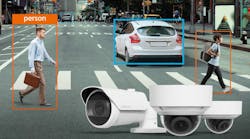"The iSentry software works by taking a video feed from any type of video camera, including old analog systems. After it is hooked up, it learns what is normal behavior in each video feed. That can take from a few hours to a day. After that, it will recognize an anomaly and anything that is not a normal behavior will create an alert."
That's how Charles Barber, president of Prescient Group, explains the basic value proposition behind iSentry, a video content analytics software now being offered in the United States by the firm he co-founded with Kendall Chen. He explains it as "black screen" technology, noting that until an alert is created, it frees the human operator from monitoring.
According to Barber, the iSentry software technology was developed in Australia and has found applications in the realm of general security, traffic monitoring, and now even the maritime environment. The technology, Barber and Chen explain, can be set up to solve the problem of too many cameras to be monitored "live".
"According to the government, we're looking at a quadrupling of video cameras watching what we do in the next five years. That means that many more feeds to watch, but where are the people coming from to watch these screens?," said Chen. "With this, you can quadruple the amount of information [being received from cameras] without having to quadruple the workforce or changing the composition of the workforce."
While video content analytics is still a new and emerging technology, there are a number of companies offering the ability to set up digital tripwires that can trigger alarms, for example, if a person or object passes a digitally established perimeter. Chen and Barber note that the iSentry solution can offer that type of solution, but that automatic learning of what is normal and what is not normal is increasingly useful, as it eases the amount of effort required to set up a solution.
"It's a learned behavior recognition system rather than a rules-based intelligent video detection system," said Barber, who notes that the system using something akin to artificial intelligence. "The system really is intelligent in its own right. Most of the competition requires you to set up very specific rules per camera."
The range of analytics is wide. The system is said to be able to detect objects left behind and objects removed. It could detect when a person or object is moving the wrong way, or when a perimeter has been breached. The iSentry system also was designed with PTZ control in mind. If a fixed camera alerts on an abnormal behavior, it can automatically bring up a PTZ camera to track that object or person, even zooming in to provide an identification of something like a face or a vehicle and license plate. When the fixed camera releases the alert, Chen noted that the system will automatically relinquish control of the PTZ so that it can go back to its normal operation, such as its standard "virtual guard tour".
Barber and Chen note that while the system is just now being introduced to the United States, the technology has already found applications around the world to monitor for intruders in secure areas of casino-hotel resort properties. They also point out that the system has even been used in retail malls for not only security applications, but also for safety, by detecting slip-and-fall type events.
Now, they're looking beyond traditional security applications, and recently presented the technology at a recent tradeshow and conference focused on intelligent traffic systems – the automated systems for monitoring road traffic. Such applications in this space, they note, could include detection of blocked intersections and management of assigned lanes on a roadway.
And even beyond the realm of traffic management, Barber and Chen – who both have backgrounds in maritime operations (Barber is a former naval officer) – say that they're introducing the solution to the maritime environment.
"What's happened is that we started talking to port authorities, they said they weren't interested in intelligent video. They didn't want to even talk about intelligent video because experience had showed them it didn't work in the maritime environment with waves, tides, reflections," Barber said.
In the case of iSentry, however, Barber noted that the R&D team has worked to make the software applicable to the maritime environment, and after showing the system to some ports, he said the tide of opinion is changing. A common application, said Barber, might be the detection of smaller vessels approaching larger vessels or the detection of persons and vessels entering restricted port areas.
The iSentry software is sold in a camera license format and runs on a Windows-type server configuration. The system connects between the cameras and the DVR or NVR, and offers its own recording ability in addition to the existing video recording devices. A single server can handle up to 16 video feeds. The solution can be delivered through a systems integrator, but Barber notes that the company can also offer the solution directly using their own staff and subcontractors. The Prescient Group is online at www.prescientgroup.us.

